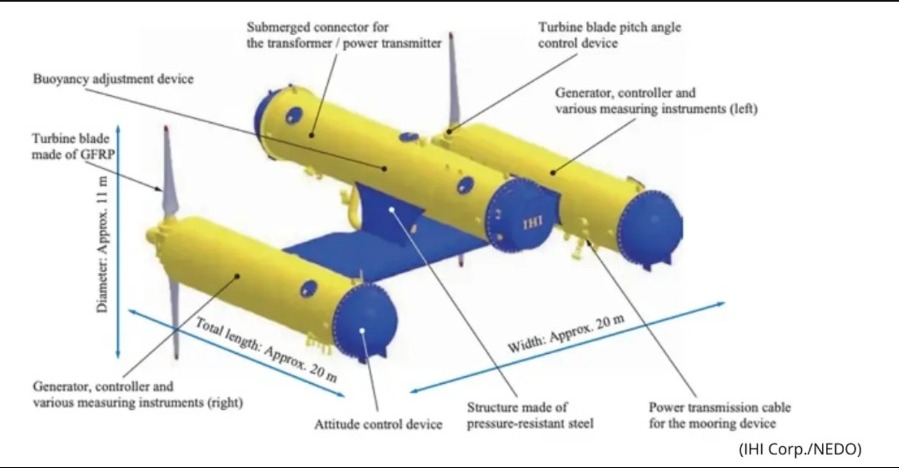World News16.06.2022
Japan testing ways to tap ocean currents for renewable energy

Japan today can generate about 205 gigawatts of electricity. Coincidentally, studies show that the energy contained in the Kuroshio current — part of the North Pacific gyre that runs along the eastern side of the country at a rate of between 2 and 4 knots — could generate as much as 200 gigawatts of clean, renewable energy in perpetuity, or at least until the sun turns into a giant red dwarf and implodes in a few billion years.
Is it possible to tap into the Kuroshio current to generate that much renewable energy? Not today, but not so long ago, solar panels and wind turbines were deemed the stuff of science fiction. In the 1980s, when the first wind turbines appeared, no one could have imagined the latest model from Siemens Gamesa with its 115-meter long blades and a swept area of nearly 11 acres producing up to 15 megawatts of electricity.
Ishikawajima-Harima Heavy Industries — known as IHI — has been exploring ways to tap the power of ocean currents to create renewable energy for more than a decade. In 2017, it partnered with New Energy and Industrial Technology Development Organization (NEDO) to put its design — a 330-ton prototype — to the test. According to Science Alert, the project passed a major milestone in February with the completion of a successful three-and-a-half year field test in the waters off Japan’s southwestern coast.
The prototype is called Kairyu, which can be loosely translated into “ocean current.” It weighs 330 tons and has a fuselage 20 meters (66 feet) long flanked by a pair of similarly sized cylinders, each containing a power generation system attached to an 11-meter long turbine blade. When tethered to the ocean floor by an anchor line and power cables, the device can orient itself to find the most efficient position to generate power from the flow of a deep water current.
Kairyu was designed to hover about 50 meters below the waves, where each of the blades rotates in opposing directions, which helps stabilize the device. In a flow of two to four knots (around one to two meters per second), Kairyu was found to be capable of churning out a total of 100 kilowatts of power.
That may seem like pretty small potatoes compared to a modern wind turbine, but now that Kairyu has proven it can withstand the forces of nature in the ocean, it could have a monster sibling with 20-meter long turbine blades to generate a more respectable 2 megawatts sometime around 2030. 100 such machines would allow Japan to derive virtually all its electricity from ocean currents.
There is enough energy in one tidal cycle in the Bay of Fundy to meet the needs of all 8 billion humans alive today. But high engineering costs, environmental limitations, proximity of coastal areas to the grid are all challenges that need to be overcome before IHI and others who are intrigued by the allure of boundless energy from the sea will see their dreams realized.
And yet, similar challenges faced early wind and solar energy operations. Undersea transmission cables already connect offshore wind farms to the mainland. There is even a proposal to send electricity from Western Australian solar farms to Indonesia via an undersea cable. The amount of energy involved in ocean currents is enormous. Whoever figures out how to tap it reliably and economically will be doing a service not only to Japan but to all humanity.
New additive strategy enhances efficiency of bifacial perovskite solar cells
India tests a totally-new source of energy
Kazakhstan and UAE reaffirm strategic energy partnership with 1 GW wind project
Solar becomes EU’s top power source for the first time ever
How decentralised renewables transform healthcare services in rural Zimbabwe
Chinese company to build solar and wind power plants in Kyrgyzstan
Seaturns raises €2.45 million to industrialize wave energy technology and accelerate global rollout
Trump signs executive order to end subsidies for wind and solar energy
Uzbekistan's solar and wind power plants generate 5 Billion kWh since beginning of the year
Green Corridor Alliance JV registered in Baku to promote green energy development in Central Asia and the South Caucasus
In the EU renewable energy supply grew by 3.4% in 2024
IRENA accepting renewable energy project proposals in Central Asia until August 15
Astana to host Electronica Expo Kazakhstan Electronics Exhibition
WB gives rundown of Azerbaijan's green energy grid volume prospects
US solar sets new records as renewables nearly match natural gas – EIA
‘Wings’ on poles: Bill Gates-backed breakthrough wind turbine facility breaks ground
Perovskite tandem solar cell achieves new efficiency record
Kazakhstan and China endorse draft SCO joint statement on sustainable energy development
Innovative research on organic solar cells for space applications
Kazakhstan and Uzbekistan drive green energy progress in Central Asia











